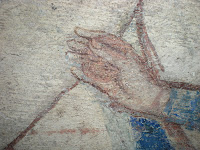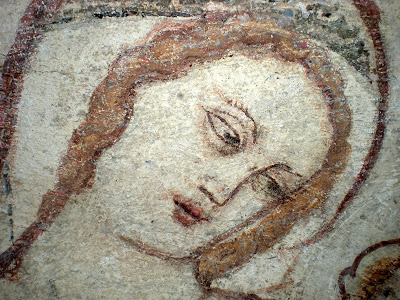Medieval History

This post focuses on the medieval fresco decoration of the Inner City parish church of Pest - you can read my introduction to the history of the building here.
Not much survived of the original painted decoration of the Inner City parish church. Knowing the history of the building, it is not surprising that all these are associated with the choir and ambulatory of the building. Over the years, the following fragments have been discovered:

These are all just very small fragments in a building the size of the Inner City parish church. Although some areas of the large wall surfaces of the ambulatory have been checked, the walls have never been systematically examined for frescoes. As a great new discovery demonstrates, there are still surprises to be found in the church.
Earlier this year, restorer Éva Derdák was called to examine the walls, as they were to be repainted. Most attention was given to the eastern wall of the ambulatory, where a walled-in wall niche was discovered. In the back wall of this niche, a beautifully preserved, almost intact fresco of the Virgin and Child was found. In front of an azurite blue background, the Virgin is shown enthroned on an elaborate throne. The Christ child is standing on her lap. The fresco has been conserved by Éva Derdák, and restored using minimal retouches.
The depiction of the Virgin and Child was on the back of the niche, in the upper part of the wall surfaces (there may have another image below it). On the narrow side walls of niche, additional figures were depicted, of which a bishop survives. The original architectural context of the fresco did not survive, but it could be established that the fresco formed the back wall of a ciborium (a canopy), and in all likelihood served as an altar picture. When the canopy had been dismantled at an unknown date, the fresco was whitewashed, and later the entire niche was walled up - preserving the image to this day.
It is clear that this fresco is earlier than the Passion-scenes in the wall niches. In fact, the fresco seems earlier than the current dating of the entire sanctuary would allow. Based on circumstantial historical evidence, construction of the large new hall-sanctuary and ambulatory had been associated with the parish priest Gergely Babócsai, royal chaplain, who has been documented in 1398. The fresco likely dates to the middle of the 14th century, forcing art historians to rethink the history of the entire building (current excavations on the outside of the church will help this process). The newly discovered fresco has been presented to the public today - now art historical work can start in earnest. The significance of the fresco, an intact image from the Angevin period, surviving right in the middle of the Kingdom of Hungary, is immense.

You can see more photos of the fresco in my Picasa album.
- 14th Century Church Fresco Uncovered In Budapest
A Hungarian priest, Zoltán Osztie, and archaeologist Imre Bodor presented a rediscovered medieval fresco to the media on Thursday. The fresco, which portrays the infant Jesus and the Virgin Mary, was uncovered on a sanctum wall behind the main altar...
- Restoration Of The Wall Paintings Of Torna / Tur?a Nad Bodvou
Detail from the Arrest of Christ (cleaned state, 2008)One of the largest restoration projects in Slovakia was completed in 2014: the restoration of the wall paintings in the sanctuary of the medieval church of Torna (Tur?a nad Bodvou). The frescoes, found...
- Late 14th Century Frescoes Discovered At Nitra Cathedral
The cathedral of Nyitra (Nitra, Slovakia) is one of the oldest, most complex, and - until quite recently - least known cathedral building of medieval Hungary. Located north-east of Pozsony/Pressburg/Bratislava, the bishopric of Nyitra was founded before...
- Medieval Wall Paintings Discovered At Magyarlóna
Cover of the book on Magyarlóna The village of Magyarlóna (formerly known as Szászlóna, now Luna de Sus, Romania) is a characteristic village of the Kalotaszeg region of Transylvania, near Kolozsvár (Cluj). The village was first mentioned...
- The Medieval Parish Church Of Pest (part I.)
The Inner City parish church is perhaps the most frequently-seen, yet most overlooked major medieval building in Budapest. Standing in the middle of the city, right next to Elizabeth bridge, modern-day citizens of Budapest zoom by it every day. The church,...
Medieval History
The medieval parish church of Pest (part II.) - A remarkable discovery
This post focuses on the medieval fresco decoration of the Inner City parish church of Pest - you can read my introduction to the history of the building here.
Not much survived of the original painted decoration of the Inner City parish church. Knowing the history of the building, it is not surprising that all these are associated with the choir and ambulatory of the building. Over the years, the following fragments have been discovered:
- Some fragments of the earliest painted decoration, found on broadstones, during excavations, surviving from the Romanesque-period chancel of the church.
- Head of a bishop and of a female figure, found on fragments of the late Gothic tabernacle. These frescoes - especially the bishop - were in quite good condition at the time of their discovery in the 1930s. They were built in when the tabernacle was reconstructed - today they are just barely legible.
| Head of a bishop, fresco fragment on the Gothic tabernacle (Condition in 1933) |
- Fragments of scenes and figures inside the wall niches encircling the choir ambulatory. These have been discovered during the 1940s, and they have been detached and restored many times. Not much remains: just two scenes - Christ on the Mount of Olives and a Calvary - can be identified, and a few heads of angels survived in the upper circle of the blind tracery articulating the niches. These frescoes can be dated to the early decades of the 15th century.
| Fragments of Christ on the Mount of Olives, with the Veil of Veronica above |
| Calvary scene in one of the wall niches |
| Angel |
- One small fragment of the decoration of the ribs of the vaulting in the chancel - this served as the basis of the present neo-Gothic interior decoration of the Gothic part of the building.
These are all just very small fragments in a building the size of the Inner City parish church. Although some areas of the large wall surfaces of the ambulatory have been checked, the walls have never been systematically examined for frescoes. As a great new discovery demonstrates, there are still surprises to be found in the church.
Earlier this year, restorer Éva Derdák was called to examine the walls, as they were to be repainted. Most attention was given to the eastern wall of the ambulatory, where a walled-in wall niche was discovered. In the back wall of this niche, a beautifully preserved, almost intact fresco of the Virgin and Child was found. In front of an azurite blue background, the Virgin is shown enthroned on an elaborate throne. The Christ child is standing on her lap. The fresco has been conserved by Éva Derdák, and restored using minimal retouches.
| The Virgin and Child enthroned (conserved state) |
It is clear that this fresco is earlier than the Passion-scenes in the wall niches. In fact, the fresco seems earlier than the current dating of the entire sanctuary would allow. Based on circumstantial historical evidence, construction of the large new hall-sanctuary and ambulatory had been associated with the parish priest Gergely Babócsai, royal chaplain, who has been documented in 1398. The fresco likely dates to the middle of the 14th century, forcing art historians to rethink the history of the entire building (current excavations on the outside of the church will help this process). The newly discovered fresco has been presented to the public today - now art historical work can start in earnest. The significance of the fresco, an intact image from the Angevin period, surviving right in the middle of the Kingdom of Hungary, is immense.
You can see more photos of the fresco in my Picasa album.
- 14th Century Church Fresco Uncovered In Budapest
A Hungarian priest, Zoltán Osztie, and archaeologist Imre Bodor presented a rediscovered medieval fresco to the media on Thursday. The fresco, which portrays the infant Jesus and the Virgin Mary, was uncovered on a sanctum wall behind the main altar...
- Restoration Of The Wall Paintings Of Torna / Tur?a Nad Bodvou
Detail from the Arrest of Christ (cleaned state, 2008)One of the largest restoration projects in Slovakia was completed in 2014: the restoration of the wall paintings in the sanctuary of the medieval church of Torna (Tur?a nad Bodvou). The frescoes, found...
- Late 14th Century Frescoes Discovered At Nitra Cathedral
The cathedral of Nyitra (Nitra, Slovakia) is one of the oldest, most complex, and - until quite recently - least known cathedral building of medieval Hungary. Located north-east of Pozsony/Pressburg/Bratislava, the bishopric of Nyitra was founded before...
- Medieval Wall Paintings Discovered At Magyarlóna
Cover of the book on Magyarlóna The village of Magyarlóna (formerly known as Szászlóna, now Luna de Sus, Romania) is a characteristic village of the Kalotaszeg region of Transylvania, near Kolozsvár (Cluj). The village was first mentioned...
- The Medieval Parish Church Of Pest (part I.)
The Inner City parish church is perhaps the most frequently-seen, yet most overlooked major medieval building in Budapest. Standing in the middle of the city, right next to Elizabeth bridge, modern-day citizens of Budapest zoom by it every day. The church,...
